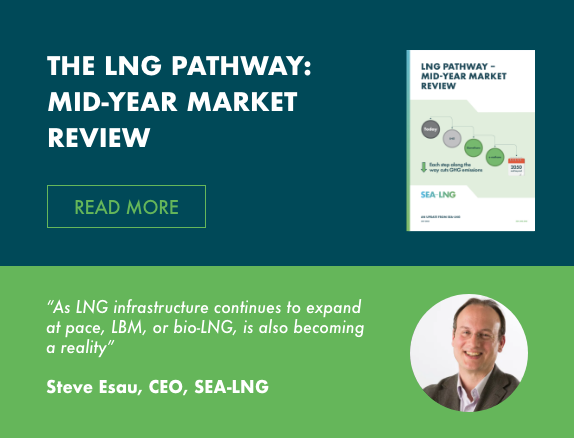27th November 2019
2020 – 2050: Tackling decarbonisation together, one step at a time, starting now

Steve Cadden from industry coalition SEA-LNG writes exclusively for Splash 24/7.
Watching the global coverage of New Delhi’s toxic air pollution reminds us why the International Maritime Organization (IMO) first introduced progressively tightening regulations to reduce sulphur oxide emissions back in 2005. While New Delhi is a city that is nowhere near the coast, the air quality and associated health challenges it is facing bear an obvious resemblance to the very issues that the IMO is tackling with the 2020 regulations. The importance of this initiative, as well as LNG’s role in achieving it, is widely agreed. But as attention now turns to the emissions reduction targets for 2030 and 2050, we must recognise that – using 2020 as the starting point – there is a pragmatic chronology to achieving a more sustainable, decarbonised future for shipping. And LNG as a marine fuel plays a central role.
As the IMO and industry explores which alternative fuels will enable us to meet these targets, never has there been a greater need for factual, quality information to assess how we are going to achieve the energy transition. And never has it been more critical for us to work collaboratively; from environmental NGOs and academics to regulators, shipowners and operators. Now is the time to stop the verbal sparring and work together to find a pragmatic route forward.
It goes without saying that the information we are basing decisions upon must be fundamentally sound. While the air quality benefits of LNG have been well documented for decades, on the carbon front, it has been six months since the publication of the Life Cycle GHG Emission study, which has become widely regarded as the definitive study into GHG emissions from current marine engines. Commissioned by SEA-LNG and SGMF and undertaken by thinkstep, it is comprehensive, using the latest primary data to assess all major types of marine engines and global sources of supply. It is quality assured assessing the supply and use of LNG as a marine fuel according to ISO standards, and is objective, having been peer-reviewed by a panel of independent, academic experts in life cycle analysis and marine engine technologies. This panel consisted of leading academics from France, Germany, Japan and the USA.
The study clearly shows that on an engine technology basis, the absolute Well-to-Wake (WtW) emissions reduction benefits, accounting for methane emissions, for LNG-fuelled engines compared with HFO fuelled ships today are between 14% to 21% for 2-stroke slow speed engines and between 7% to 15% for 4-stroke medium speed engines. Importantly, 70% of the marine fuel consumed today is by 2-stroke engines with a further 18% used by 4-stroke medium speed engines.
From the study’s inception, we have been keen to encourage discussion of the analysis and engage with informed industry commentators. To that end the thinkstep study clearly sets out all data sources, assumptions and the methodology used. It also compares the results against those reported by other recent studies and provides an explanation for any differences. To date, we have only received one detailed critique of the analysis. That critique was based on unrealistic operating assumptions, the use of emissions data from older engine technologies, and extrapolation of results from marine engines operating in regional coastal shipping not global shipping trades.
While meeting the IMO carbon targets of 2050 requires the introduction of zero emission technologies, the reality is that they are simply not ready and nor will they be for the foreseeable future. This was underlined by a recent study from DNV GL which concluded that while there are a variety of lower or zero carbon alternative fuels that could help to meet the goals of the IMO’s 2030 and 2050 greenhouse gas reduction targets, many of these alternatives require significant development to meet the industry’s needs.
Alternative fuels such as hydrogen and ammonia may have a role to play in certain maritime applications in the future. But, as the DNV GL study highlights, these alternatives currently lack the regulatory framework, production capability, and bunkering infrastructure for widespread adoption. The main challenge for ammonia, as recently acknowledged by Maersk, for example, is that it is highly toxic and even small accidents can create major risks to the crew and the environment. The transition from current to future applications is also a huge challenge.
This is why we cannot, and must not, doubt the pragmatic pathway to 2050 that LNG offers. When combined with Energy Efficiency Design Index (EEDI) improvements to ship design, LNG is forecast to meet the IMO 2030 target for decarbonisation on new ships. And the expected developments in bio and synthetic methane provide LNG users a pathway to 2050 and beyond. As bio and synthetic LNG are mutually interchangeable with LNG derived from fossil feedstocks, assets will not become stranded and this therefore represents the most compelling decarbonisation journey, starting now, for deepsea shipping.
With 2020 now upon us, and a stark reminder from New Delhi of how significantly air quality impacts human health, let’s ensure we all work together to address the air quality concerns that IMO 2020 effectively addresses. At the same time the maritime industry, academics and NGOs must develop collaborative solutions, based upon technologies that are achievable, as we take the next step on the road to a zero-emissions industry. If we’re to make effective, meaningful progress with emissions reductions across the board, waiting for utopia and the ‘perfect but as yet unknown’ solution is simply not an option. We must continue to act from today. And LNG is the only option that moves us forward, now.
Source: http://splash247.com/2020-2050-tackling-decarbonisation-together-one-step-at-a-time-starting-now/
TwitterLinkedIn



